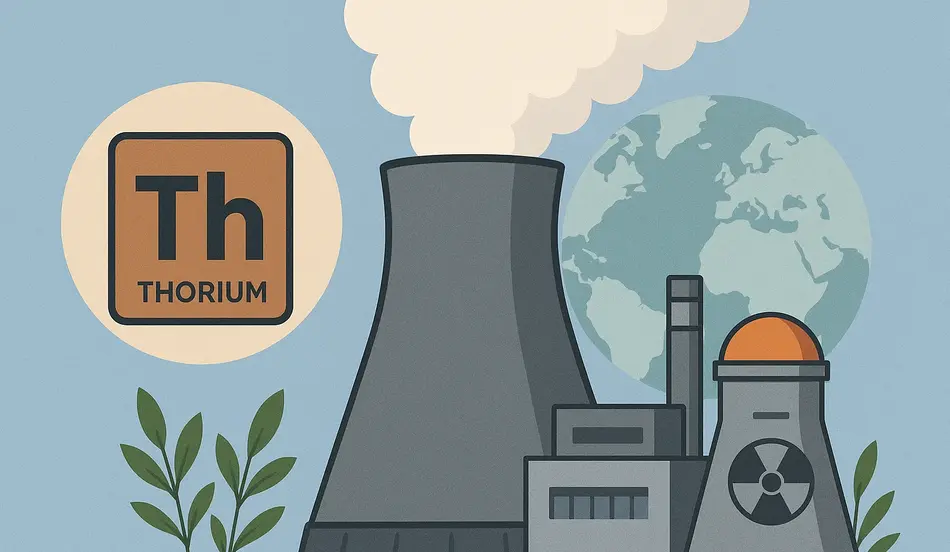The global energy landscape stands at a crossroads, with thorium emerging as a potentially revolutionary power source that could address many of the challenges facing both traditional fossil fuels and conventional nuclear energy. This abundant element offers remarkable efficiency, enhanced safety, and significantly reduced waste – yet remains largely untapped as an energy solution.
The Remarkable Potential of Thorium Nuclear Energy
Imagine holding enough energy in your palm to power your entire life. This isn’t science fiction—it’s the remarkable reality of thorium, a naturally occurring element that could revolutionize how we generate electricity. With just 5,000 tons of thorium, we could supply the entire planet with energy for a year. Even more impressive, thorium can be utilized approximately 200 times more efficiently than uranium, dramatically reducing waste generation by factors of hundreds compared to conventional nuclear power and by factors of millions compared to fossil fuels.
Since the industrial revolution, humanity has relied heavily on burning fossil fuels to power our modern world. While effective, this approach comes with severe drawbacks: significant air pollution, billions in healthcare expenses from related illnesses, and millions of preventable deaths. The nuclear age that followed World War II initially seemed promising, offering amazingly efficient power generation. However, public image problems and fears of nuclear disasters have hampered its widespread adoption.
Enter thorium—what many scientists consider the perfect solution to our energy challenges. It’s abundant in the Earth’s crust, less volatile and reactive than uranium, and perhaps most importantly, a nuclear plant powered by thorium physically cannot suffer from the type of catastrophic meltdown that has defined nuclear accidents in the public consciousness.
How Thorium Nuclear Reactors Work: The Science Behind the Revolution
Understanding the Thorium Fuel Cycle
Thorium (specifically thorium-232) is a naturally occurring element found abundantly in rock deposits worldwide. Unlike uranium-235, thorium isn’t fissile by itself, meaning it cannot sustain a nuclear reaction on its own. However, it is fertile, which means it can be transformed into a fissile material with some assistance.
The process works like this:
- Thorium-232 absorbs neutrons, transforming into thorium-233
- Thorium-233 undergoes beta decay to become protactinium-233
- Protactinium-233 can be extracted and decays into uranium-233
- Uranium-233 is a usable nuclear fuel that can sustain a reaction
This transformation process highlights one of the key differences between thorium and uranium fuel cycles. At the dawn of the nuclear era, scientists had three main options:
- Uranium-235 (fissile form that could be used directly)
- Uranium-238 (had to be transformed into plutonium)
- Thorium-232 (had to be transformed into uranium-233)
The Game-Changing Role of Molten Salt Reactors
Traditional nuclear reactors use solid fuel rods and pressurized water cooling, making it difficult to extract materials mid-reaction. This limitation makes the thorium fuel cycle impractical in conventional reactors. However, molten salt reactors (MSRs) solve this problem by using liquid fuel instead of solid rods.
In an MSR, salt flows through pipes and is heated to remain molten at approximately 1,200°F. This salt doesn’t react with air, flows like water, but doesn’t boil. This liquid state makes it much easier to isolate protactinium and continue the thorium fuel cycle efficiently.
The liquid fuel design offers another critical advantage: safety. Unlike conventional water-cooled reactors that must maintain incredibly high pressures to prevent water from boiling away, molten salt reactors can operate at low pressure. In case of emergency, the fuel automatically drains away using gravity, preventing the catastrophic chain reactions that led to disasters like Three Mile Island, Chernobyl, and Fukushima.
Four Compelling Advantages of Thorium Nuclear Energy
1. Unparalleled Abundance
Thorium is remarkably plentiful in the Earth’s crust—at least three times more abundant than uranium. In China alone, thorium reserves could theoretically power the country’s energy needs for the next 20,000 years. Globally, thorium is so common that we wouldn’t even need dedicated thorium mines; it’s already a byproduct of existing mining operations, particularly rare earth mineral extraction.
“We can power our civilization on thorium without opening a single thorium mine,” notes one expert in the field. “It is already a plentiful byproduct of existing mining operations.”
2. Enhanced Safety Profile
Thorium’s non-fissile nature provides greater control over nuclear reactions. The design of molten salt reactors eliminates the need for high-pressure water systems used in traditional designs, significantly reducing the risk of steam explosions and other accidents.
In the Chinese thorium reactor, for instance, if conditions become unstable, a plug at the bottom of the reactor automatically melts, allowing the fuel to drain out using gravity. This passive safety feature presents a much more favorable scenario than the unstoppable chain reactions that have occurred in traditional reactor accidents.
While some thorium advocates emphasize that the fuel is “proliferation resistant” (difficult to use for weapons), others note that these safety claims may be somewhat exaggerated—just as the risks of conventional nuclear power are often overstated in public discourse.
3. Dramatically Reduced Waste
Unlike conventional nuclear power, thorium reactors don’t emit greenhouse gases. More importantly, while uranium waste remains hazardous for tens of thousands of years, thorium waste becomes relatively safe in just a few hundred years—a dramatic improvement in waste management timelines.
For countries like China, obtaining thorium fuel could come with virtually zero additional environmental impact, as thorium is already a waste product of the country’s extensive rare earth mining industry.
4. Unmatched Energy Efficiency
Perhaps most impressive is thorium’s energy density. Thorium generates up to 200 times more energy than uranium for the same amount of fuel. To put this into perspective, if a uranium “battery” provides one day of power, a thorium battery of identical size would power your devices for approximately 6.5 months.
This extraordinary efficiency is visualized clearly when comparing the energy output-to-input ratios of different power sources. Molten salt thorium reactors dramatically outperform traditional nuclear reactors, not to mention fossil fuel technologies.
Learn more about emerging energy technologies at the U.S. Department of Energy.
🔬 Hiring? Connect with Nuclear Energy Professionals
Are you recruiting for positions in nuclear engineering, energy research, or related fields? Connect with qualified candidates by posting your job openings for free on WhatJobs and reach professionals with expertise in next-generation energy technologies.
🚀 Post Your Job for Free NowThe Curious Case of Thorium’s Abandonment
Despite thorium’s immense potential compared to uranium, operational thorium reactors remain as rare as unicorns. Currently, there’s only one functioning thorium reactor in the world, located in China’s Gobi Desert. Ironically, this Chinese achievement was built upon American research that was abandoned decades ago.
The Oak Ridge Experiment: America’s Forgotten Innovation
In the 1960s, Oak Ridge National Laboratory in Tennessee conducted groundbreaking research on thorium-fueled molten salt reactors under the direction of Alvin Weinberg. The Molten Salt Reactor Experiment ran from 1965 to 1969 with incredibly promising results, quickly becoming the foundation for all subsequent molten salt reactor designs.
Weinberg had a transformative vision for thorium energy. He saw it not only as a solution to America’s energy needs but as a technology that could “transform the economic balance of the world” by enabling desert regions to desalinate water and grow crops in previously uninhabitable areas.
Yet despite its promise, the experiment was shut down. In his writings, Weinberg questioned: “Why didn’t the molten salt system, so elegant and so well-thought out, prevail? There were no technical reasons why the molten salt reactor was not pursued.”
Political and Military Priorities
During the Cold War, uranium fever dominated America’s nuclear strategy. The Pentagon prioritized faster breeder reactors that could fuel the nuclear arms race. Thorium’s safety advantages and its unsuitability for weaponry were actually disadvantages in this political climate.
Weinberg’s persistent advocacy for thorium safety eventually led to his reassignment. As he later reflected, “Our problem is not that the idea is poor, it’s that it’s different from the mainstream and too chemical to be fully appreciated by non-chemists.”
The Oak Ridge experiment was defunded, Weinberg was reassigned, and the thorium blueprints gathered dust—until the early 2000s, when NASA engineer Kirk Sorenson rediscovered them while researching power solutions for lunar colonies.
Explore more about the history of nuclear energy development at the World Nuclear Association.
China’s Thorium Renaissance
While Sorenson’s enthusiasm for thorium fell on deaf ears in America, one country was paying close attention: China. Chinese researchers recognized that a thorium-fueled molten salt reactor could solve their growing energy needs while securing their national interests.
In 2009, China’s thorium project formally began. Construction started in 2018, with hundreds of scientists working relentlessly, often on-site for more than 300 days per year. They meticulously studied declassified American documents, replicated experiments, and designed new materials.
Project lead Zu Hong Xia summarized their approach: “Rabbits sometimes make mistakes and grow lazy. That’s when the tortoise seizes its chance.” And seize it they did. In 2023, China’s thorium molten salt reactor achieved a sustained nuclear chain reaction, and by June 2024, the reactor was operational.
During a closed-door meeting at the Chinese Academy of Science, Zu stated: “The US left its research publicly available, waiting for the right successor. We were that successor. We mastered every technique in the literature, then pushed it further. We are now at the frontier of global nuclear innovation.”
The Reality Check: Challenges Facing Thorium Adoption
Despite the promising developments in China, thorium power faces significant hurdles before widespread adoption becomes reality.
Historical Context and Economic Challenges
Contrary to popular belief, there have been several commercial thorium plants since the late 1940s in Germany, India, the Netherlands, and the United States. However, none survived past the 1980s. While some plants experienced design problems, economics played a major role in their demise.
The process of extracting thorium from ore and converting it into fertile fuel for nuclear purposes proved considerably more expensive than uranium processing. Although thorium can theoretically produce 200 times the energy of equivalent uranium, this requires continuous reprocessing of the fuel.
As a thorium plant operates, waste products accumulate and affect the core’s performance. Maintaining long-term operation requires expensive reprocessing facilities and procedures.
Material Science Limitations
Molten salt reactors present unique materials challenges. The salt mixture is extremely hot and corrosive to surrounding materials. Developing components that can withstand these conditions long-term has been a significant obstacle.
The Chinese appear to be addressing this issue with a custom alloy called Hastelloy-N, specifically designed to withstand the harsh conditions inside thorium reactors.
Current Progress and Future Outlook
China’s test reactor, while groundbreaking, remains small—rated for just 2 megawatts of heat. For context, MIT’s research reactor (a conventional nuclear reactor) is three times that size. However, China plans to scale up with a 60-megawatt reactor by 2030.
The Chinese scientists recently achieved another world first by adding fresh fuel to the thorium reactor while it was running, proving that continuous operation is possible.
Other countries and companies are also entering the race:
- Copenhagen Atomics plans to test a molten salt thorium reactor in Switzerland in 2026
- India, with the world’s largest thorium reserves, continues research despite political complications
- Multiple startups in the US and other countries are working to revive molten salt reactor development
⚡ Find Engineering Jobs in Emerging Energy Sectors
Ready to build the future of clean energy? Explore high-demand roles in nuclear, solar, wind, and green hydrogen innovation. WhatJobs connects engineers with forward-thinking employers in the next-generation energy space.
🔎 Explore Energy Engineering Jobs NowFAQ: Thorium Nuclear Energy Revolution
What makes thorium potentially revolutionary compared to traditional nuclear energy sources?
The thorium nuclear energy revolution centers on four transformative advantages that distinguish it from conventional uranium-based nuclear power. First, thorium’s remarkable abundance—at least three times more common than uranium—means a single mine could theoretically extract enough thorium to power the entire planet, with China’s reserves alone potentially sufficient for 20,000 years of national energy needs. Second, thorium’s enhanced safety profile stems from both its non-fissile nature (requiring deliberate transformation to become fuel) and the molten salt reactor design, which physically prevents Chernobyl-style meltdowns through passive safety features like gravity-driven fuel drainage systems. Third, thorium produces dramatically less waste that remains hazardous for hundreds rather than tens of thousands of years. Finally, thorium’s unmatched efficiency—generating up to 200 times more energy than uranium from the same amount of fuel—represents an energy density revolution that could fundamentally transform global power production while minimizing environmental impact.
Why was thorium nuclear energy development abandoned in the United States despite its promising early research?
The abandonment of thorium nuclear energy development in the United States represents a complex intersection of Cold War politics, military priorities, and institutional inertia rather than technical limitations. During the 1960s, Oak Ridge National Laboratory conducted groundbreaking research on thorium-fueled molten salt reactors under Alvin Weinberg’s direction, with highly promising results. However, the Pentagon’s focus on uranium-based reactors that could produce plutonium for nuclear weapons made thorium’s non-proliferation advantages actually disadvantageous in that political climate. As Weinberg himself noted, “There were no technical reasons why the molten salt reactor was not pursued.” His persistent advocacy for thorium safety eventually led to his reassignment. Additionally, the nuclear establishment was dominated by physicists familiar with solid fuel designs, while thorium molten salt technology required chemical expertise. As Weinberg explained, “Our problem is not that the idea is poor, it’s that it’s different from the mainstream and too chemical to be fully appreciated by non-chemists.” This combination of military priorities, institutional resistance to change, and specialized knowledge requirements effectively sidelined what might have been America’s energy future.
What technological breakthroughs has China achieved with its thorium nuclear energy program?
China’s thorium nuclear energy program has achieved several groundbreaking technological milestones that position the country at the forefront of this revolutionary energy technology. Most significantly, in 2023, China’s thorium molten salt reactor achieved a sustained nuclear chain reaction—the first operational thorium-based molten salt reactor in decades—becoming fully operational by June 2024. The Chinese team also accomplished a world-first by successfully adding fresh fuel to the thorium reactor while it was running, proving continuous operation is possible without shutdown cycles. To overcome one of thorium’s biggest challenges—material degradation from hot, corrosive molten salts—Chinese scientists developed a custom alloy called Hastelloy-N specifically designed to withstand these extreme conditions. Project lead Zu Hong Xia summarized their methodical approach: “We mastered every technique in the literature, then pushed it further. We are now at the frontier of global nuclear innovation.” While their current test reactor is relatively small at 2 megawatts thermal output, China plans to scale up with a 60-megawatt reactor by 2030, demonstrating a clear pathway from experimental proof-of-concept to commercial viability.
What practical challenges must be overcome before thorium nuclear energy can achieve widespread adoption?
Despite thorium’s promising theoretical advantages, several substantial practical challenges must be overcome before thorium nuclear energy revolution can achieve widespread adoption. First, economic hurdles remain significant—historical attempts at thorium power plants in Germany, India, the Netherlands, and the US all failed economically by the 1980s because extracting thorium from ore and maintaining the fuel cycle proved more expensive than uranium processing. Second, material science limitations present ongoing engineering challenges, as the extremely hot, corrosive molten salt environment degrades conventional materials over time, requiring specialized alloys and components with unproven long-term performance. Third, regulatory frameworks worldwide are designed around solid-fuel uranium reactors, creating significant licensing barriers for fundamentally different thorium molten salt designs. Fourth, the thorium fuel cycle requires continuous reprocessing facilities that add complexity and cost compared to once-through uranium fuel cycles. Finally, there’s the challenge of market inertia—the global nuclear industry has decades of experience with uranium technology, established supply chains, and trained personnel, while thorium would require building entirely new infrastructure and expertise. As Copenhagen Atomics and other companies work toward commercial thorium reactors in the coming years, these practical challenges will determine whether thorium fulfills its revolutionary potential or remains primarily a promising laboratory concept.
Explore career opportunities in advanced nuclear technologies on WhatJobs
Conclusion: The Future of Thorium Energy
The thorium story illustrates both the power of public research and how easily promising innovations can stall without sustained support. As Zu Hong put it, “To achieve something meaningful in this field, you must have perseverance and be prepared to dedicate 20 to 30 years to one single pursuit.”
If thorium proponents are correct, nations could power entire cities with minimal environmental impact. There would be dramatically reduced need for fossil fuels, expensive and short-lived wind turbines, or solar panels that degrade over time. Since molten salt reactors don’t require water cooling, they could operate in deserts or even space—thorium is common on the moon and easily detectable from orbit due to its electromagnetic signature.
Critics argue that many promising claims are oversimplified, and the road to thorium adoption will be long and challenging. China has made impressive progress, but it’s still early days—their test reactor is tiny compared to commercial power plants.
The thorium debate continues to generate passionate views on both sides. Is it truly the clean energy revolution of the future, or should we focus our resources elsewhere? The coming decade may finally provide definitive answers to this long-standing energy question.




